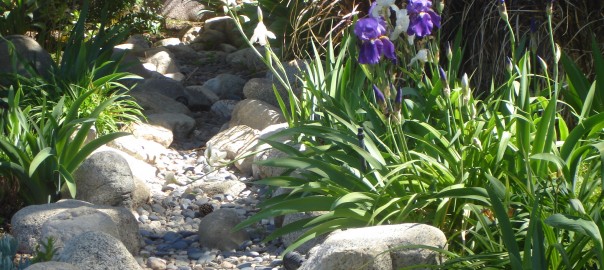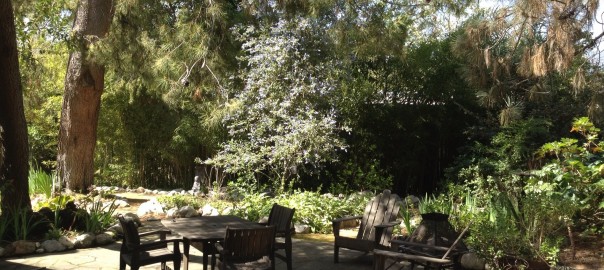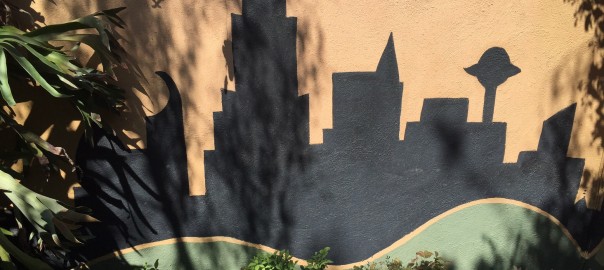Californians, when presented with problems, tend to look for answers; which is what has occurred with our ongoing drought. One of the first projects I worked on when I moved to California 26 years ago was a Water Wise Demonstration garden for the San Bernadino Water District. At the time it seemed odd to me as I was used to making sure water shed properly off of a site rather than trying to capture it. As I researched for this project it became apparent to me that drought is a natural part of the weather cycle of the West. A cycle tends to last seven years, wet for seven years, then dry for the next, then repeat. With our poplulation continually growing these dry periods are growing more difficult. There is actually plenty of water, but we landscape architects have been trained to moved water away from houses quickly to the storm drains. Currently our fundamental change in our design of gardens as we now want to allow that rain water a chance to absorb into the ground, repleneshing our ground water.
With each of our garden designs, we consider how to create a garden that absorbs more water without causing a flood. It is a delicate balance. The solution must also be appropriate for the way the garden is intended to be used by the residents and guests.
Perhaps our greatest inspiration is a natural feature in California called “Vernal Pools”. They are simply temporary ponds. Most of the year they are dry, but during rains they fill up with water, as the water is absorbed into the ground specific wild flowers germinate and fill the pools with plants that expedite the grounds ability to absorb that pooled water. We have adapted this natural feature in the gardens we design. It is important that these depressions look beautiful year round.
So first on our list in garden design is where to create a swale, (a drainage depression)–a place where we can safely move water coming from the gutters and water running off the property to a place designed to capture a large portion of that water, allowing overflow to drain away. Then we select plant material and other materials that will aid the ground in absorbing that water.
Another way we capture water in the garden is using less concrete, substituting gravel, pavers, decomposed granite, and porous concrete. These materials allow the water to be absorbed into the ground by slowing down the runoff, allowing the ground to absorb it. It’s also a good idea to look at existing paving and deciding how that surface can be reduced, too. Even breaking up sections of concrete and planting a tree can help immensely.
There has also been a great movement to use only native plants. I generally agree with this. But, there are some amazing plants on our planet. Most of which can handle drought if established properly. The key to establishing plants is making sure they are in their proper conditions. All plants have a preference in soil types (acid or alkaline), some like well drained soils, others prefer heavy clay soils…. Etc…. My only issue with California natives, is they tend to be rather big, so they need to be planted with room to grow. There are small plants, but typically the ones that catch our eye are the big ones, which is why they are more readily available. We use plants as architecture and as tools to help the soil thrive. There are some amazing American Native plants that work well in California gardens.
Rain Barrels are another water to capture water…. But typically they are just too small to make a real impact. They can fill up in minutes. They are still a good way to capture some water! A better solution is a large sisters that can water your whole garden. Although they are somewhat of a temporary status symbol, they require a location where they become a cohesive part of the working garden. Rain water is far superior to irrigation. Our water contains flouride and chlorine, which plants do not need. Irrigation sustains, rain nurtures.
I think one of the simplest ways to help capture water is to make sure your garden soil isn’t compacted. Most of our soils are… It can be quite diffuclt to aerate soils with existing plantings. It is best to do this as a garden is begun. To keep a well aerated soil, it is important to add compost, and organic nutrients to the soil. Gardeners typically blow out leaf litter, but those leaves are free nutrients and mulch.
It is also important to maintain ones’ irrigation system. If your system leaks then any water conservation is pointless. Also, make sure faucets and hoses do not leak. Overspray is another wasteful byproduct of irrigation. Changing the heads on your existing irrigation system is an easy fix. The new heads are much more specific as to how they water. Also, water less often, but for longer periods. This allows more water to seep into the ground. Watering the top inch of soil does not promote healthy growth. This is why there is root damage, and toppeled trees.
So, one can see there is something we can do to survive a drought not just in a drought, but when we have rains! Let’s work together to create beautiful gardens that say we are problem solvers!


